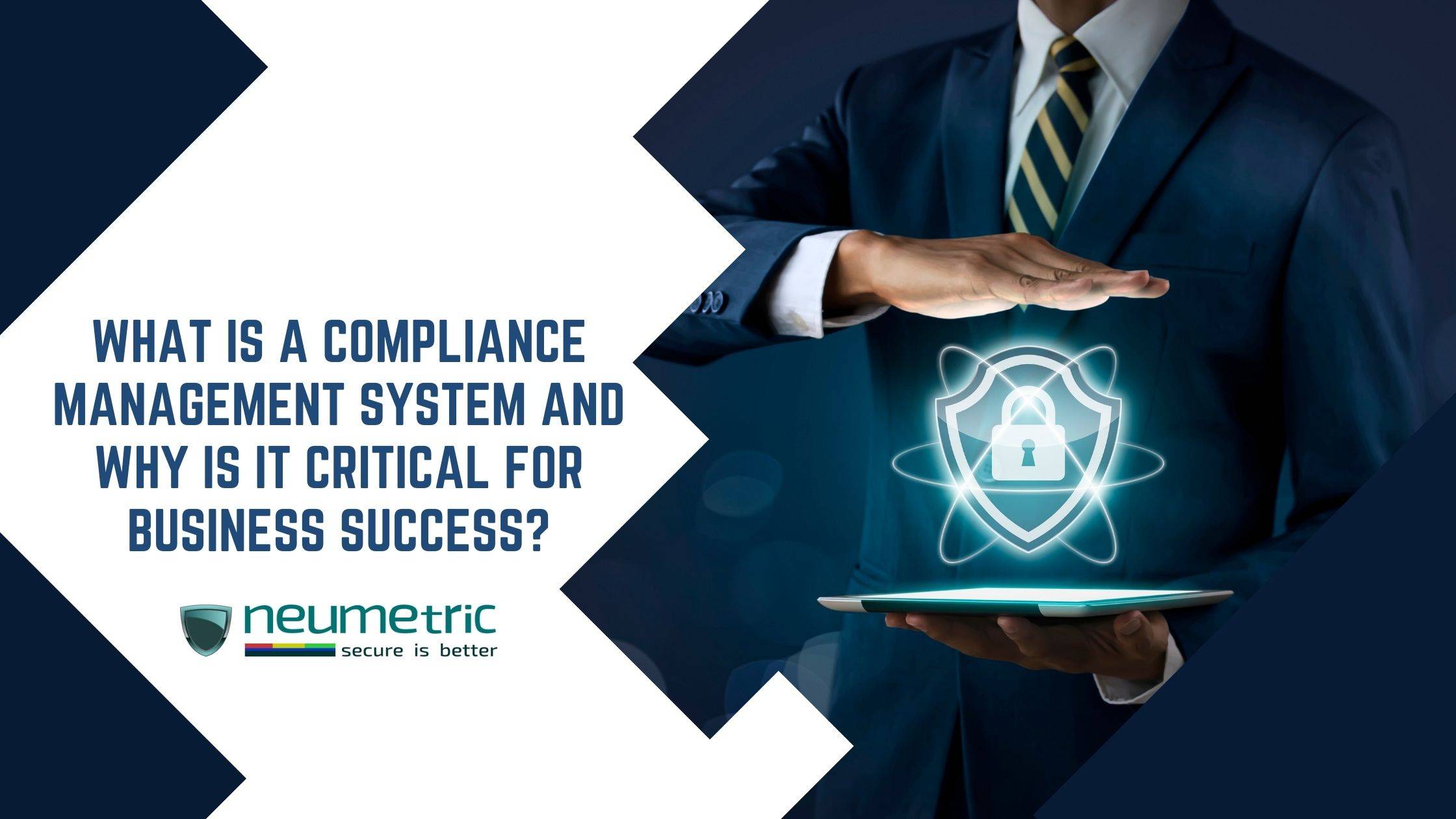Table of Contents
ToggleWhat is a Compliance Management System and why is it critical for business success?
Introduction
The term Compliance Management System [CMS] refers to a structured framework & set of processes implemented by businesses to ensure they adhere to relevant laws, regulations, industry standards & internal policies. It involves the identification, assessment, mitigation & monitoring of compliance risks within an organisation. Businesses risk reputational & financial harm, administrative penalties & potential legal actions if they don’t have a CMS that works.
Businesses can gain much from Compliance Management System [CMS] implementation by using one that is effective. These advantages include boosting stakeholder trust & reputation, increasing operational effectiveness, gaining a competitive edge & simplifying regulatory reporting & auditing. A Compliance Management System [CMS] can assist firms in achieving effective & comprehensive risk management, complying with changing regulatory frameworks & mitigating legal & financial risks.
This journal’s mission is to examine the notion of Compliance Management System [CMS], its goals & its essential elements.
Understanding Compliance Management Systems
Compliance Management System [CMS] consists of an integrated system of documents, processes, tools, internal controls & functions to make it easier for organisations to comply with regulatory & legal requirements. CMS also minimises harm to consumers because it drives compliance with the law.
In order to maintain continual improvement & development of the Compliance Management System & services provided, the following objectives will be maintained & monitored:
- Customer Satisfaction
- Effective Leadership
- Employee Motivation
- Continual Improvement
- Effective Financial Management
- Effective Management of the Quality Management System
- Health & Safety Principles
- Access to Adequate Resources
- Control & Reduce Environmental Impact
An effective Compliance Management System [CMS] should include several key features & components including governance & leadership, risk assessment & mitigation strategies, policies, procedures & controls, training & awareness programs.
Implementing Compliance Management System [CMS] can provide several benefits for regulatory compliance. Here are some key benefits:
- Centralised Compliance Efforts
- Efficient Compliance Monitoring
- Risk Identification & Mitigation
- Streamlined Reporting & Documentation
- Enhanced Collaboration & Communication
- Scalability & Adaptability
- Continuous Improvement
Regulatory Landscape & Compliance Challenges
In Today’s business environment, organisations must navigate a complex web of regulations & industry standards to ensure compliance. The specific regulations & standards applicable to a business depend on factors such as industry, location & the nature of its operations. Here are some examples:
- General Data Protection Regulation [GDPR]: Pertaining to the protection of personal data for individuals in the European Union, the GDPR imposes strict requirements on data privacy, consent, security & breach notification.
- Health Insurance Portability & Accountability Act [HIPAA]: Applicable to Healthcare organisations in the United States, HIPAA safeguards Protected Health Information [PHI] & establishes requirements for privacy, security & data breach notification.
- Payment Card Industry Data Security Standard [PCI DSS]: Governing organisations that handle Credit Card & Debit Card transactions, PCI DSS mandates security measures to protect cardholder data, including network security, encryption & vulnerability management.
Common Compliance Challenges faced by businesses:
- Complex regulatory landscape: The ever-changing regulatory landscape, with a multitude of overlapping regulations & standards, poses difficulties in understanding & implementing compliance requirements.
- Lack of awareness & understanding: Organisations may struggle with a lack of awareness & understanding of the specific compliance obligations that apply to their industry or operations.
- Rapidly evolving technology: The adoption of emerging technologies, such as cloud computing, artificial intelligence & big data, introduces new compliance challenges.
Proactive Compliance Management through the implementation of a Compliance Management System [CMS] is critical for several reasons:
- Risk mitigation: CMS allows organisations to identify & assess compliance risks, enabling proactive implementation of controls & mitigation measures. By addressing compliance issues before they escalate, organisations can reduce legal, financial & reputational risks.
- Proactive compliance culture: Implementing CMS fosters a culture of compliance within the organisation. It raises awareness, promotes accountability & encourages employees to take ownership of compliance responsibilities.
- Consistency & standardisation: CMS provides a centralised framework for managing compliance, ensuring consistent practices & adherence to regulations across the organisation. Standardisation promotes efficiency, reduces errors & enhances the organisation’s ability to demonstrate compliance to regulators & stakeholders.
Key Elements of a Compliance Management System
A Compliance Management System typically includes the following key elements:
- Governance & leadership commitment: This involves establishing a code of ethics & conduct, defining roles & responsibility & creating a compliance committee to oversee the Compliance Management System.
- Risk assessment & mitigation strategies: This involves conducting a comprehensive risk assessment to identify potential compliance risks & implementing measures to mitigate & manage those risks.
- Policies, procedures & controls: This involves creating & implementing policies, procedures & controls to guide compliance efforts, including policies for managing conflicts of interest, protecting confidential information & ensuring compliance with applicable laws & regulations.
- Training & awareness programs: This involves providing training & awareness programs to help employees understand the importance of compliance, the risks associated with non-compliance & their individual roles & responsibilities in maintaining compliance.
- Monitoring & auditing processes: This involves monitoring & auditing compliance efforts to identify areas of non-compliance & potential risks & implementing corrective actions as needed.
- Incident management & response mechanisms: This involves establishing incident management & response mechanisms to handle violations of policies or laws, including measures to investigate, sanction & remediate incidents as appropriate.
By incorporating these key elements into a Compliance Management System, organisations can help ensure that they are meeting legal & ethical obligations, mitigating risks & fostering a culture of compliance.
Business Benefits of a Compliance Management System
A Compliance Management System offers several business benefits that can positively impact an organisation’s operations, reputation & market position. Here are five key business benefits:
- Mitigation of legal & financial risks: Implementing a Compliance Management System helps identify, assess & mitigate legal & financial risks associated with regulatory non-compliance. By ensuring adherence to applicable laws, regulations & industry standards, the system reduces the likelihood of fines, penalties, lawsuits & reputational damage that can arise from non-compliant activities.
- Enhanced reputation & stakeholder trust: Maintaining a robust Compliance Management System demonstrates a commitment to ethical business practices & regulatory compliance. This commitment enhances an organisation’s reputation, builds stakeholder trust & fosters positive relationships with customers, investors, employees & regulatory authorities.
- Improved operational efficiency & consistency: An effective Compliance Management System establishes standardised processes & procedures across the organisation, promoting operational efficiency & consistency.
- Competitive advantage & market differentiation: Organisations that prioritise compliance & embed it into their culture gain a competitive advantage in the marketplace. Compliance Management Systems can differentiate a company by showcasing its commitment to ethical practices, regulatory compliance & risk mitigation.
- Facilitation of regulatory reporting & audits: Compliance Management Systems provide a structured framework for capturing, organising & reporting data required for regulatory compliance. This streamlines the preparation & submission of regulatory reports, reducing the time & effort involved.
Implementing a Compliance Management System
Implementing a Compliance Management System typically involves a number of key steps, including:
- Conducting a compliance gap analysis: This involves identifying any areas where the organisation may be at risk of non-compliance & comparing current practices with regulatory requirements.
- Establishing a compliance framework & structure: This involves organising the Compliance Management System within the organisation, including assigning responsibilities, roles & reporting lines.
- Developing & implementing policies & procedures: This involves creating the necessary policies & procedures to ensure compliance with regulatory requirements.
- Training & educating employees on compliance requirements: This involves educating employees on the importance of compliance & providing training on specific compliance requirements.
- Monitoring & Evaluating Compliance Effectiveness: This involves ongoing monitoring of the organisation’s Compliance Management System to assess effectiveness, identify weaknesses & areas for improvement & make changes as needed.
Technology & Automation in Compliance Management
Technology & automation play a crucial role in streamlining compliance management processes. Here are three key aspects of how technology is used in compliance management. Technology offers various tools & solutions that simplify & streamline compliance processes. These include:
- Centralised data management: Compliance Management Systems leverage technology to centralise & organise compliance-related data, including policies, procedures, training materials & regulatory requirements.
- Risk assessment & management: Technology enables organisations to automate the process of identifying, assessing & managing compliance risks. Risk management software can help prioritise risks, track mitigation measures & provide real-time risk reporting & analytics.
- Training & awareness: Technology-based training platforms & Learning Management Systems [LMS] enable organisations to deliver compliance training programs efficiently. These platforms offer features such as online courses, quizzes, certifications & progress tracking.
Compliance Management Software & Tools provide comprehensive solutions for managing compliance activities. These tools often include features such as:
- Compliance tracking & monitoring: Software solutions allow organisations to track & monitor compliance activities, deadlines & milestones. They can send automated reminders, generate reports & provide real-time visibility into compliance status.
- Document management & version control: Compliance software enables efficient document management, ensuring proper version control, access control & document tracking.
- Regulatory change management: Compliance tools help organisations stay updated with regulatory changes. They provide alerts & notifications about new or modified regulations relevant to the business, enabling timely action & adaptation of compliance processes.
- Compliance monitoring: Automated Monitoring Systems can continuously monitor transactions, activities & data to detect potential compliance issues or anomalies.
- Compliance reporting: Technology allows for the automation of compliance reporting processes. Compliance management software can generate standardised reports, compile data from various sources & generate compliance dashboards. This streamlines reporting, ensures accuracy & saves time & effort.
- Compliance documentation: Technology enables automated documentation processes, such as the generation of compliance policies, procedures & audit trails.
By leveraging technology & automation in compliance management, organisations can streamline processes, improve efficiency, enhance accuracy & effectively meet regulatory requirements, ultimately reducing risks & ensuring ongoing compliance.
Continuous Improvement & Adaptation
Continuous Improvement & Adaptation are crucial aspects of a Compliance Management System [CMS]. A CMS is not a one-time implementation but an ongoing process that requires constant evaluation, enhancement & adaptation to effectively address compliance challenges.
- Ongoing Evaluation: Regular Evaluation of the CMS helps identify its strengths, weaknesses & areas for improvement. This evaluation can involve assessing the effectiveness of policies, procedures, controls, training programs & monitoring mechanisms.
- Monitoring Regulatory Updates: Compliance Requirements are subject to change due to new laws, regulations or industry standards. It is crucial for organisations to stay informed about these updates & assess their impact on their CMS.
- Incorporating Feedback: Feedback from employees, stakeholders, regulators & auditors provides valuable insights into the effectiveness of the CMS. By actively seeking & incorporating feedback, organisations can identify areas where the CMS may fall short or need improvement.
Conclusion
In this journal, we explored the criticality of a Compliance Management System [CMS] for business success. We discussed the definition & importance of a Compliance Management System , its key components & the benefits of implementing a CMS for regulatory compliance. A Compliance Management System is not just a regulatory requirement but also it is a strategic asset that contributes to the overall success of a business.
It helps organisations navigate complex regulatory environments, mitigate risks & safeguard their reputation. By implementing a robust Compliance Management System [CMS], businesses can ensure compliance with applicable laws, regulations & industry standards, thereby reducing legal & financial risks. It minimises legal & financial risks, safeguards the organisation’s reputation & enhances stakeholder trust.
FAQs:
What is a Compliance Management System?
A Compliance Management System [CMS] is a framework that enables organisations to effectively manage & adhere to legal & regulatory requirements. It is a systematic approach that encompasses policies, processes, controls & procedures to ensure compliance with applicable laws, regulations, industry standards & internal policies.
What are the four components of a Compliance Management System?
The four components of a Compliance Management System are:
- Policies & Procedures
- Risk Assessment & Management
- Training & Education
- Monitoring & Auditing
What is an example of a Compliance Management System?
An example of a Compliance Management System is a software platform that helps organisations manage their compliance efforts. Such a system may include features like policy management, risk assessment, training tracking, incident reporting, audit management & document management.
What is the role of a Compliance Management System?
The role of a Compliance Management System is to ensure that organisations comply with relevant laws, regulations & industry standards.





